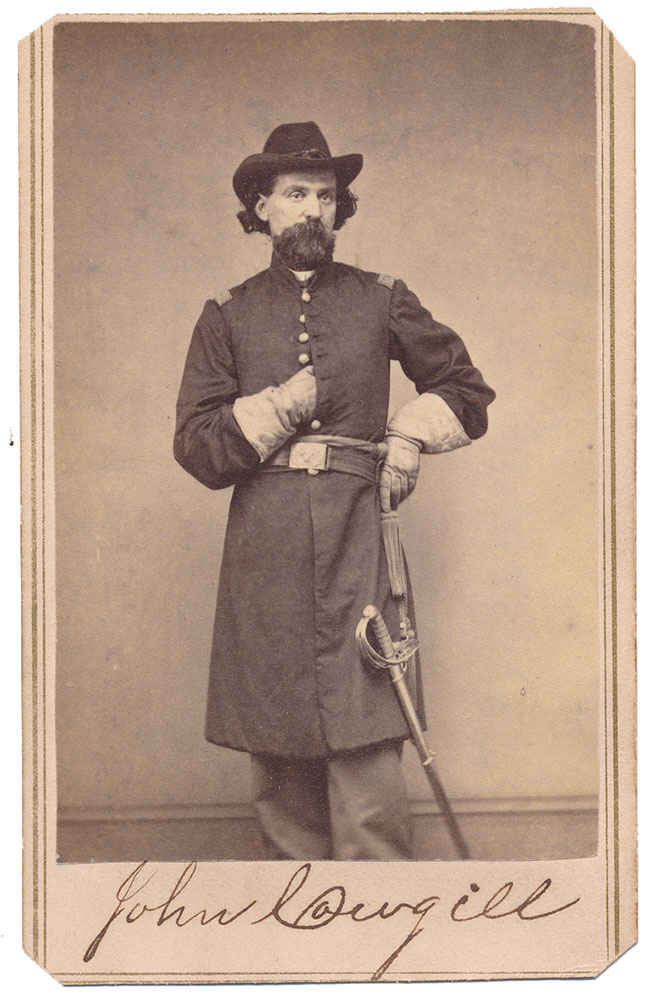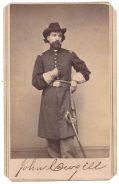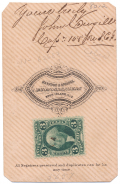site search
online catalog
INK SIGNED THREE-QUARTER STANDING VIEW OF 108TH USCT CAPATIN JOHN COWGILL OF MARYLAND – FROM A WELL-KNOWN LOCAL QUAKER ABOLITIONIST FAMILY

$145.00 SOLD
Quantity Available: None
Item Code: 160-454
CDV shows Captain John Cowgill in a typical Napoleonic pose with one had tucked in his coat. He wears a dark slouch hat and dark single-breasted frock coat with light trousers. Coat has shoulder straps and at his waist is his sash and sword belt with attached non-regulation import officer’s sword.
Contrast and clarity are excellent. Mount corners are clipped and the top edge is trimmed. Paper is good. Bottom center has period ink “JOHN COWGILL.”
Reverse has a photographer’s imprint for GAYFORD & SPEIDEL… ROCK ISLAND, ILLS. Top has very nice period ink inscription “YOURS TRULY JOHN COWGILL, CAPT. 108TH U.S.C.T.” Bottom also has a green 3 cent tax stamp.
A published biography of Cowgill appears in “The Archives of Maryland: Biographical Series” as follows:
“John Cowgill was a captain of United States Colored Troops during the Civil War and his family contributed their land to the founding of Unionville, a town composed largely of African American veterans and their families.
John Cowgill was born on February 8, 1832 in Delaware. He was the son of Ezekiel Cowgill and Sarah Gordon Cowgill. The Cowgills and their extended family were Quakers and known abolitionists. Ezekiel and Sarah were active members of the Camden Monthly Meeting, and although there is no evidence that John Cowgill ever became a member of a Quaker meeting as an adult, it is likely that he grew up attending meeting with his family. Many Quakers in Delaware aided Underground Railroad, and it is probable that the Cowgills were acquainted with John Hunn, the Chief Engineer of the Underground Railroad of Delaware, who is buried in the Camden Monthly Meeting cemetery. Additionally, Ezekiel Cowgill corresponded with Thomas Garrett, a Delaware Quaker who rose to prominence after his trial in Roger B. Taney's courtroom in 1848 for aiding the Hawkins family in their escape from slavery.
In 1856, when John was twenty-five years old, Ezekiel purchased Lombardy, a farm on Miles River Neck, located in Talbot County, Maryland. By the time of the 1860 census, John Cowgill was living in Talbot County with his parents. The majority of the land on Miles River Neck belonged to the Lloyd family. Colonel Edward Lloyd VI's plantation depended on the labor of hundreds of slaves. Ezekiel Cowgill was a devoted abolitionist who was struck by his slaveholding neighbors. In Ezekiel's writings he described Miles River Neck as "the great hotbed and stronghold of American Slavery" and he referred to his neighbors as "the Goliaths, Nebuchadnezzars and Pharaohs of the peculiar institution—can I desire to fraternize with such and to partake of their abominations?” The Cowgills' orchards and fields were tended by free laborers who received payment for their work, a practice that Ezekiel described as an "honest living," but also one that he noted made his farm unprofitable. Ezekiel's sons also helped him run the farm. In 1860, John was recorded as a farmer in the census, and by 1863, John's brother, James, had arrived in Talbot County. In 1870, Ezekiel Cowgill was a retired farmer, and James, who had probably taken over the management of Lombardy, was recorded in the census as a farmer.
John Cowgill was twenty-eight years old when he was drafted into the Union Army in 1863. Although he was drafted, it is likely that Cowgill joined the Union Army willingly, since his family was wealthy enough to buy his way out of the war. This is supported by the fact that his brother, James, did not serve in the Union Army despite being eligible for and recorded in the draft. By the time of the draft in 1863, John Cowgill had already served on Marshal McPhail's guard. The most well-known action of Marshal McPhail in Talbot County was the notorious arrest of pro-Southern Judge Richard B. Carmichael in his own courtroom-- it is unknown whether John Cowgill was present for the arrest. John Cowgill became the captain of Company A of the 108th Regiment of United States Colored Infantry. Cowgill was present for the fortification of Louisville, Kentucky in 1864. Although the attack never came to Louisville, he wrote in a letter to his mother that "The Authorities here are expecting an attack and I hope they may be gratified provided the Colored Troops and their officers escape which is rather doubtful as there are no white troops for the defense of the City." Although John's service in the Union Army clashed with his Quaker parents' devotion to pacifism, his letters to them during the war and afterward suggest that his relationship with his family did not suffer after he became a soldier.
In 1865, John Cowgill was transferred as a captain in Company I of the US 2nd Volunteers, a regiment that was composed of ex-Confederate prisoners of war. He was stationed at Fort Salina and Fort Larned. He spent the rest of the war in Kansas; his duties included escorting wagon trains on the road from Fort Larned to Leavenworth, a journey that, according to a letter he wrote to his mother, took forty days to complete including the return trip.
After the war, John Cowgill returned to his family's home on Miles River Neck in Talbot County and married Emma Banning. In 1870, John was a wealthy lumber merchant, and he and his wife, along with their children, Daniel and Emma, were living near John's parents on Miles River Neck. Beginning in 1867, John's father, Ezekiel, began to lease portions of his land to returning veterans of the United States Colored Troops; the majority of these veterans and their families had lived on Miles River Neck before the war, as slaves on the Lloyd plantation. Popular legend maintains that John Cowgill and the veterans of Unionville were compelled to don their uniforms again after the end of the war; however, the stories vary as to why, according to Dickson Preston, the veterans went to Easton to protect African American voters on election day, but another account states that they were protecting a black political speaker.16 His niece, Katherine Cowgill, believed that the basic story could be true, writing that John was "a wild young blade... he may well have indulged in such a wild freak as reported- as well as many others."
John Cowgill left Talbot County sometime after 1870, and by 1880 he was living as a lumber manufacturer in White Stone, Virginia. His household consisted of his wife and children, along with three African Americans, Judy Tayler, William Thomas, and Prude Henderson. Cowgill was the census recorder in White Stone in 1880.
John Cowgill did not remain in Virginia for very long, and by 1886 he had moved to Washington D. C. In January of 1881, while John was still living in White Stone, Virginia, he mentioned in a letter to his father that he was applying for a job at the Treasury Department. It is possible that he got the post and that was the reason behind his move to Washington D. C. As early as 1886, John and his family were living in the St. Cloud Building on 28th and F Streets. In December of that year, he wrote a letter from the St. Cloud Building to his brother, James, asking to borrow money in order to buy a better position where he was employed. He wrote that the new job would allow him to support his family "much more comfortably than we are now living... I want this money to buy out a party now occupying the position." It is not known whether nor not he got the promotion that he was pursuing. John applied for his pension while in D. C. in 1891.
John Cowgill's later years are difficult to trace, and there is much about his life, and especially the lives of his wife and children, that are unknown. A "John Cowgill" appears in the District of Columbia City Directory from 1887 to 1915. In 1887 he is recorded as a canvasser living at 819 F Street SW and in 1889 he appears as an insurance agent living at 530 9th Street NW. In 1891, John Cowgill was a secretary living at 919 Florida Avenue. From 1892 to 1896, while living at that same address, he was recorded as a laborer. In 1899, while still living on Florida Avenue John began working at the Government Printing Office. Finally, from 1899 until 1915 he continued working at the Government Printing Office and lived on I Street NE. It is not certain that the John Cowgill who appears in the City Directory is the correct John Cowgill; however, there are no other John Cowgills appearing in the directory and the steady progression of careers and addresses suggests that the directory records the same John Cowgill from 1887 to 1915. Additionally, this record is consistent with the known death date of John Cowgill. According to the records of Arlington National Cemetery, Captain John Cowgill died on December 21, 1915. He is buried in grave 3561-WS, Section 2, at Arlington National Cemetery.” [ad][ph:L]
~~~~~~~~~~~~~~~~~~~~~~~~~~~~~~~~~~~
THIS ITEM, AS WITH ALL OTHER ITEMS AVAILABLE ON OUR WEB SITE,
MAY BE PURCHASED THROUGH OUR LAYAWAY PROGRAM.
CLICK HERE FOR OUR POLICIES AND TERMS.
THANK YOU!
Inquire About INK SIGNED THREE-QUARTER STANDING VIEW OF 108TH USCT CAPATIN JOHN COWGILL OF MARYLAND – FROM A WELL-KNOWN LOCAL QUAKER ABOLITIONIST FAMILY
For inquiries, please email us at [email protected]
Most Popular
Historical Firearms Stolen From The National Civil War Museum In Harrisburg, Pa »
Theft From Gravesite Of Gen. John Reynolds »
Cavalry Carbine Sling Swivel »
Fine Condition Brass Infantry Bugle Insignia »
featured item
CONFEDERATE CLIP POINT BOWIE WITH SALVAGED MUSICIAN SWORD BRASS HILT
This clip-point Bowie a great example of southern improvisation- a kind of weapons-making version of folk art – not sophisticated, but with an appeal of it own. Measuring 19.5 inches overall, the knife has a 13.25 inch blade that is 1.5 inches… (490-3265). Learn More »




